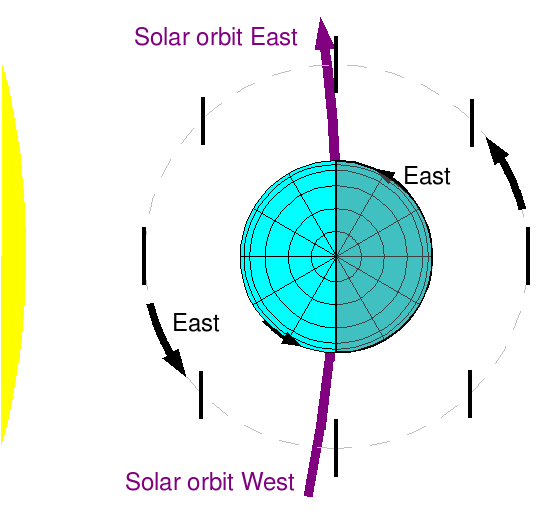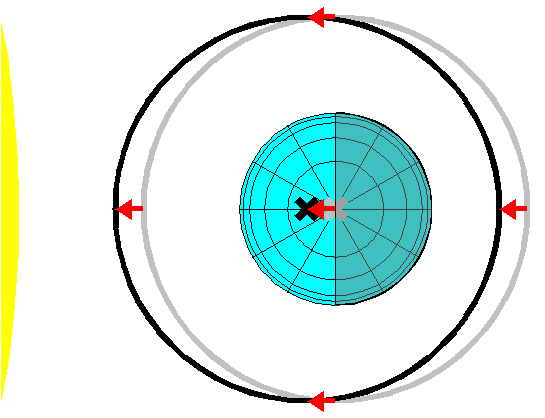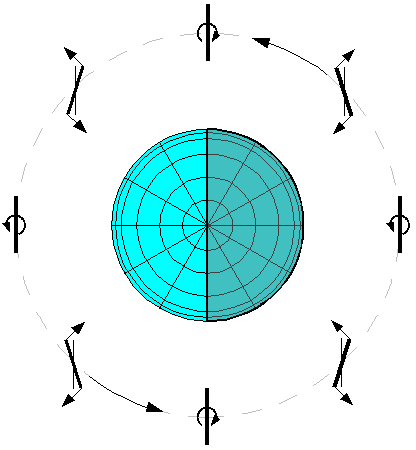|
Size: 8490
Comment:
|
Size: 9432
Comment:
|
| Deletions are marked like this. | Additions are marked like this. |
| Line 7: | Line 7: |
| ||{{attachment:nav_eastwest.png}}|| The earth rotates towards the east, counterclockwise when viewed from the north pole. It makes 366.24 turns relative to the fixed stars per year, and makes 365.24 turns relative to the sun. Orbits launched from earth also travel east, only faster. On the surface of the rotating earth at midnight, east is in the direction of the earth's orbit around the sun, and on the surface of the rotating earth at noon, the earth appears to be moving west. For the sake of argument, we will assume that the '''earth is moving east in its orbit'''. Thus, an object in orbit around the earth is moving towards the sun on the east side of the earth, and away from the sun on the west side of the earth. ''' I may have this backwards compared to some convention, so please add a note and a reference if I goofed this up! '''|| |
||{{attachment:nav_eastwest.png|defining east and west in solar orbit|height=285}}||'''Defining directions'''<<BR>>The earth rotates towards the east, counterclockwise when viewed from the north pole. It makes 366.24 turns relative to the fixed stars per year, and makes 365.24 turns relative to the sun. Orbits launched from earth also travel east, only faster. On the surface of the rotating earth at midnight, east is in the direction of the earth's orbit around the sun, and on the surface of the rotating earth at noon, the earth appears to be moving west. For the sake of argument, we will assume that the '''earth is moving east in its orbit'''. Thus, an object in orbit around the earth is moving towards the sun on the east side of the earth, and away from the sun on the west side of the earth. ''' I may have this backwards compared to some convention, so please add a note and a reference if I goofed this up! '''|| |
| Line 12: | Line 11: |
| The effect of the solar pressure is a continuous force outwards from the sun - which is approximately the same effect as if the gravitational center of the earth moves inwards, At the server sky m288 orbit, the earth gravitational tidal gradient (not including the inertial component) is twice the angular frequency squared, or approximately 4E-7 (radians/second)^2^ . The solar gravitational tidal gradient (including the inertial component) subtracts from this, but is relatively small (about 1.2E-13 (radians/second)^2^ ). The effective center of the orbit is moved inwards by 2E-5/4E-7 or 50 meters, | ---- /!\ '''Edit conflict - other version:''' ---- ||{{attachment:light-shift.png}}||The effect of the solar pressure is a continuous force outwards from the sun - which is approximately the same effect as if the gravitational center of the earth moves inwards, At the server sky m288 orbit, the earth gravitational tidal gradient (not including the inertial component) is twice the angular frequency squared, or approximately 4E-7 (radians/second)^2^ . The solar gravitational tidal gradient (including the inertial component) subtracts from this, but is relatively small (about 1.2E-13 (radians/second)^2^ ). The effective center of the orbit is moved inwards by 2E-5/4E-7 or 50 meters,|| ---- /!\ '''Edit conflict - your version:''' ---- ||{{attachment:light-shift.png|orbit shifted by light pressure|height=209}}||The effect of the solar pressure is a continuous force outwards from the sun - which is approximately the same effect as if the gravitational center of the earth moves inwards, At the server sky m288 orbit, the earth gravitational tidal gradient (not including the inertial component) is twice the angular frequency squared, or approximately 4E-7 (radians/second)^2^ . The solar gravitational tidal gradient (including the inertial component) subtracts from this, but is relatively small (about 1.2E-13 (radians/second)^2^ ). The effective center of the orbit is moved inwards by 2E-5/4E-7 or 50 meters,|| ---- /!\ '''End of edit conflict''' ---- |
| Line 15: | Line 21: |
| Future versions of the server-sat will be lower mass, more subject to light pressure, and consequently shifted further in. A 1.5 gram server-sat orbit center will be 1 kilometer closer to the sun than the center of the earth. This suggests that arrays of server-sats should be segregated by their mass to area ratios, eventually by combining the high mass arrays into a few arcs of orbit and lower mass arrays into others. | Future versions of the server-sat will be lower mass, more subject to light pressure, and consequently shifted further in. A 1.5 gram (5 micrometer thick) server-sat orbit center will be 1 kilometer closer to the sun than the center of the earth. This suggests that arrays of server-sats should be segregated by their mass to area ratios, eventually by combining the older high mass arrays into fewer arcs of orbit and lower mass arrays into others. |
| Line 31: | Line 37: |
| === Correcting for tidal forces === {{attachment:tidal1a.png}} At the four "45 degree" points in the orbit, the server-sat is accelerated by tidal forces - the nearer end is pulled inwards by slightly more gravity and slightly less acceleration, and the farther end is pushed outward. These tidal forces are proportional to the vertical distance: {{ attachment:tidal-eq010.png }} where M is the effective mass at distance L from the center, <<BR>> {{ attachment:tidal-eq018.png }} is the angular frequency of the orbit, <<BR>> and {{ attachment:tidal-eq015.png }} is the angle of the disk from the tangent of the orbit. <<BR>> The torque is proportional to the horizontal distance, or {{ attachment:tidal-eq020.png }}. <<BR>> The torque and the angular acceleration are maximized at a 45 degree angle. Both the torque and the moment of the server-sat are proportional to M and L squared, so the angular acceleration is {{ attachment:tidal-eq030.png }} <<BR>> This can be integrated twice to find the angular displacement from flat towards the sun: {{ attachment:tidal-eq040.png }} <<BR>> The maximum angular displacement is given by {{ attachment:tidal-eq050.png }} |
||{{attachment:tidal1.png}}||'''Correcting for tidal forces'''<<BR>>At the four "45 degree" points in the orbit, the server-sat is accelerated by tidal forces - the nearer end is pulled inwards by slightly more gravity and slightly less acceleration, and the farther end is pushed outward. These tidal forces are proportional to the vertical distance: {{ attachment:tidal-eq010.png }} where M is the effective mass at distance L from the center, {{ attachment:tidal-eq018.png }} is the angular frequency of the orbit, and {{ attachment:tidal-eq015.png }} is the angle of the disk from the tangent of the orbit. The torque is proportional to the horizontal distance, or {{ attachment:tidal-eq020.png }}. <<BR>> The torque and the angular acceleration are maximized at a 45 degree angle. Both the torque and the moment of the server-sat are proportional to M and L squared, so the angular acceleration is {{ attachment:tidal-eq030.png }}. This can be integrated twice to find the angular displacement from flat towards the sun: {{ attachment:tidal-eq040.png }}. The maximum angular displacement is given by {{ attachment:tidal-eq050.png }}|| |
Server-sat propulsion, navigation, and orientation
A server-sat is light enough to be significantly accelerated by light pressure. At the earth's distance from the sun, the illumination is 1300 Watts per square meter, on average. The light pressure for absorbed light is the power divided by the speed of light, or about 4E-6 N/m2 or 4 microPascal. If the light is reflected, the pressure doubles to 8 microPascal. This is a tiny pressure (sea level atmospheric pressure is 100 kiloPascals) but it is continuous. When pushing on something as thin and light as a server-sat, it can add significant velocity over hours, weeks, and years. The areal density of a 100 micron thick server-sat is 0.233kg/m2 , and the albedo of a solar cell is around 0.15, so the acceleration is 1.15x4e-6/0.233 or approximately 20 micrometers/second2, or 7 centimeters/minute2, or 256 meters/hour2. That allows for significant local maneuvering.
Large orbital changes are harder. Server-sats are in orbit, and if they are pointed directly at the sun, they are accelerated directly away from it. That adds to orbital velocity as their orbit takes them away from the sun, but subtracts from orbital velocity as they approach it. If they are tilted in relation to the sun, less area is exposed to light pressure, and the "albedo vector" of reflected light is tilted also, which can add a small sideways thrust.
|
Defining directions |
Server-sats will get the most power if they face directly into the sun. However, they tilt to manuever. and that reduces the thrust. If they are tilted 45 degrees sideways, they get 30% less light and must reduce computing and radio functions, but they will still operate. With a 60 degree tilt, they get half power (and they cool down a lot!). Infrared light from the earth is mostly absorbed by the server-sat, and that creates some light pressure, too.
![]() Edit conflict - other version:
Edit conflict - other version:
|
The effect of the solar pressure is a continuous force outwards from the sun - which is approximately the same effect as if the gravitational center of the earth moves inwards, At the server sky m288 orbit, the earth gravitational tidal gradient (not including the inertial component) is twice the angular frequency squared, or approximately 4E-7 (radians/second)2 . The solar gravitational tidal gradient (including the inertial component) subtracts from this, but is relatively small (about 1.2E-13 (radians/second)2 ). The effective center of the orbit is moved inwards by 2E-5/4E-7 or 50 meters, |
![]() Edit conflict - your version:
Edit conflict - your version:
|
The effect of the solar pressure is a continuous force outwards from the sun - which is approximately the same effect as if the gravitational center of the earth moves inwards, At the server sky m288 orbit, the earth gravitational tidal gradient (not including the inertial component) is twice the angular frequency squared, or approximately 4E-7 (radians/second)2 . The solar gravitational tidal gradient (including the inertial component) subtracts from this, but is relatively small (about 1.2E-13 (radians/second)2 ). The effective center of the orbit is moved inwards by 2E-5/4E-7 or 50 meters, |
![]() End of edit conflict
End of edit conflict
perhaps a little less if the average tilt differs from zero degrees.
Future versions of the server-sat will be lower mass, more subject to light pressure, and consequently shifted further in. A 1.5 gram (5 micrometer thick) server-sat orbit center will be 1 kilometer closer to the sun than the center of the earth. This suggests that arrays of server-sats should be segregated by their mass to area ratios, eventually by combining the older high mass arrays into fewer arcs of orbit and lower mass arrays into others.
MORE LATER
Light pressure from LCD thrusters
The version 1 design has three round liquid crystal light pressure thrusters at 120 degree angles around the periphery. These are either black or transparent. They are 10cm in diameter (about 4 inches), and have areas of 8e-3 m^2. When black, an ideal thruster produces perhaps 32 nano-Newtons, and when transparent it produces zero. Assume that the glass makes it somewhat reflective, and the transparency is a bit more reflective. Also, radiation from the earth (both albedo and infrared) reduces the effective thrust. So, the thrust may vary between 30nN and 10nN (WAG). If one thruster on one side is fully black, while the other two are clear, the thrusters together produce a moment of 20nN times 20 cm or 4 nano-Newton-meters. If the entire server-sat has a mass of 0.03 kg and an average moment arm of 10 cm, the angular acceleration is 200 micro-radians per second squared. Accelerating for 36 seconds, then decelerating (applying opposite acceleration) for 36 seconds, will turn the array 10 degrees. Accelerating for 90 seconds, then decelerating for 90 seconds, turns the array approximately 60 degrees (not quite, as the thrusters are moving out of plane and become less effective when turned away from the sun). This will vary somewhat depending on the position of the earth relative to the plane of the server-sat.
Recovering from a spin
Imagine some perturbation like a collision starts the server-sat spinning end over end at 1 revolution per second. Assume that the processors and memory and transmitters go into low power standby mode when this happens, so that power remains for the receivers (for orientation) and for the LCD thrusters. The solar cell, when back-lit, will still produce some power, and the capacitors can hold some energy and preserve processor state while the solar cell is precisely edge-on to the sun.
We will be turning on the LCD thrusters moving towards the sun, and turning off the thrusters moving away. The angular acceleration averages out to something like half the peak angular acceleration (both the thrust and the arm distance vary as a rectified sine wave), so the average deceleration is 100 micro-radians per second squared. The rotation (starting at 2 pi radians per second) can be stopped in 63000 seconds, or about 18 hours.
While this is inconvenient, the perturbations that start such fast spins are extremely rare. Even if the spin was 60Hz, as fast as an AC motor, it would take about 44 days to remove it. The LCD thrusters can be turned on and off very quickly, and use no fuel, so they can remove spins that no normal satellite could recover from.
Although this is the "natural" oscillation if the server starts out flat, this is a metastable balance. Other perturbations such as the sun and the moon will eventually displace the server into its lowest energy configuration, which is coplanar with the orbit. Hence, we will need at least some correction of the orientation.
Fortunately, the LCD thrusters are much more powerful than the tidal forces, and can easily keep the server flat towards the sun. The maximum angular acceleration of the server-sat is ![]() or 0.28 micro-radians per second squared, while the thrusters can provide angular accelerations of 200 micro-radians per second squared.
or 0.28 micro-radians per second squared, while the thrusters can provide angular accelerations of 200 micro-radians per second squared.
MORE LATER



